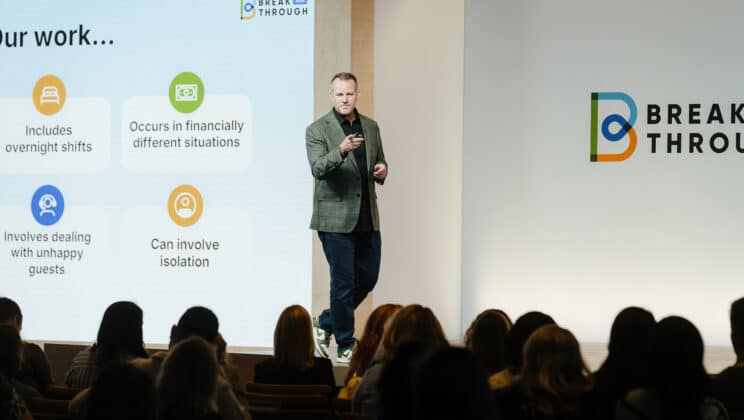Employee Retention: Strategies to Become an Employer of Choice
Win the competition for talent by attracting, retaining, and nurturing great employees.

Employee retention is a top business priority for many organizations. From improving productivity and morale to boosting company performance, the rewards of retaining top talent are worth the investment.
But the competition for top talent is fierce, and quick fixes like office perks aren’t helping companies retain employees. With a proactive employee retention plan that focuses on creating a mentally healthy workplace, you can keep your top performers and secure a competitive advantage. We’ll uncover the causes and effects of turnover and share expert retention strategies that will help your business thrive.
What is employee retention?
A basic retention definition is the percentage of people who stay employed by an organization.
Here’s a formula for how to measure employee retention:
x 100
A related concept is employee turnover. A basic turnover definition is the number of employees who leave an organization. Turnover can be voluntary (an employee chooses to leave) or involuntary (as a result of layoff or termination). The goal is to achieve a high retention rate and low turnover rate.
Annual employee turnover is calculated by measuring:
x 100
What is a “good” turnover rate”? It varies by industry, region, and the types of roles in your organization. The Bureau of Labor Statistics reports that rates range from about 15 percent to 85 percent. Every organization’s ideal turnover rate is different, and requires consideration of their historical turnover rate, their internal promotion rate, and other factors.
Employee retention rate and turnover rate are some of HR’s most important metrics. These figures provide valuable insight into whether your employee retention programs are creating a positive employee experience or if changes are needed.
How long do most people stay at their jobs?
For salary and wage workers, the median length is 4.1 years. Employee tenure is three times higher among older workers (9.9 years for ages 55 to 64) than younger workers (2.8 years for ages 25 to 34).
Salary & Wage Employees
Ages 55 - 64
Ages 25 - 34
Benefits of employee retention
There’s growing recognition that putting employees first—even before customers—can boost business success. When employees have a good work experience, they’re more likely to stay with an organization. Some of the benefits of employee retention include:
Lower costs
The price of ineffective talent retention strategies can be steep. Voluntary employee turnover costs U.S. businesses $1 trillion per year. While some turnover is expected, too much can take a toll. Replacing an employee can cost 50 percent or more of their annual salary when accounting for recruiting, hiring, and training. Costs add up even more when you factor in the time managers spend interviewing and onboarding new hires, which takes time away from their current work and staff. All told, employee turnover costs can have a significant impact on company performance.
Increased productivity and engagement
Employee turnover also factors into employee productivity. Onboarding new hires and getting them up to speed takes time—by some estimates, as much as one to two years to reach the productivity of an existing employee. This is time the employee and their manager could’ve spent on other tasks, and that your organization could’ve spent on increasing productivity rather than recruiting.
Employees who stay with their company 10-plus years tend to be more engaged and productive than newer workers. They understand company processes and systems, they’ve honed their abilities so they can produce good work quickly, and they’re more likely to have more influential roles, which makes them feel invested in the company’s success.
Talent retention fuels employee engagement and in turn, engagement increases retention. Highly engaged employees are 1.8 times more likely to say they’ll still be at their current company in a year.
Better customer experiences
Happy, long-term employees tend to provide better customer service. They approach their jobs with a combination of positive attitudes and the knowledge to solve complex problems. Tenured employees also have opportunities to develop consistent connections with customers, which builds rapport and brand loyalty.
Conversely, some of the effects of employee turnover are a disjointed customer experience and reduced confidence in the company. In some industries, when employees leave they take with them customers they’ve built strong relationships with, which can affect revenue.
Stronger company culture
Staff retention and work culture have a symbiotic relationship. Consistent, productive working relationships contribute to healthy company culture, and strong work culture is a key driver of employee loyalty.
Higher morale
When valued employees leave, it can be discouraging and disruptive for their teams. It may also prompt colleagues to reconsider their reasons for staying. A low turnover rate, on the other hand, builds camaraderie and collaboration and sends a message that the company is a great place to work.
Better ability to attract top talent
In this digital age, employees can easily publicize what it’s like to work at your organization. When their experiences are mostly positive, you increase employee loyalty and your people become brand ambassadors. Low turnover and high engagement can boost your company’s reputation, making it easier to attract the right talent for the job.
Deeper expertise
Over time, employees build knowledge, abilities, and skills that bolster your organization’s performance. When they leave, they take all that with them. One of the benefits of employee retention is that workers use the skills they’ve developed during their tenure with you to enhance your organization’s success, rather than your competitors’.
Less burden on other employees
When an employee resigns, it takes time to fill their role. Often, this means other employees have to reprioritize and do extra work to make up for their teammate’s absence. If this goes on too long, it can be a recipe for stress and burnout that delivers a double blow to productivity.
The importance of employee retention is clear. But it’s not about retaining just any employees—the benefits of employee retention only apply if your organization is attracting and retaining talented employees who are actively engaged, not underperforming talent. That’s why it’s critical to take steps toward securing your position as an employer of choice, so you can attract and retain the best talent.
Get expert tips on how to attract top talent.
Causes of employee turnover
Why do good employees quit? Low pay, limited opportunities for advancement, and disrespect are top concerns, according to a Pew Research Center survey. Note that many of the leading factors are within employers’ control. Here’s a closer look at the most common causes of employee turnover:
Low pay
Compensation was workers’ number-one reason for quitting in the Pew Research survey. While pay is understandably important, things like work-life balance and company culture are becoming top priorities, too.
Bad management
It’s often said that “people leave managers, not companies.” Research backs this up: One poll cited employees’ relationship with their boss as the number-one reason for leaving a job. Managers are crucial in creating a supportive team culture, problem-solving, and setting a healthy example. Without the right training, managers may engage in behaviors that work against your employee retention strategies, such as expecting 24/7 availability or treating people unfairly.
Untreated mental health conditions
Employee turnover is sometimes a byproduct of unaddressed workforce mental health challenges. In one survey, 50 percent of employees reported leaving a role due to mental health reasons. Also, workers with depression experience much higher job turnover than those without it, even if they’re able to keep up with the demands of their jobs.
Inadequate benefits
Benefits are important to your people. In a LinkedIn report, 60 percent of job seekers cited compensation and benefits as a top priority when choosing a job. In addition to traditional offerings like paid time off and health insurance, employers are also offering mental health support and other highly desired benefits to stay competitive and meet their employees’ most vital needs.
Poor engagement
Employee engagement and retention go hand in hand. Disengaged employees are at greater risk of turnover. By comparison, companies that score in the top 20 percent in engagement have 59 percent less employee turnover and consequently, lower hiring costs.
Lack of work-life balance
Poor work-life balance can lead to burnout and high turnover. However, when people can successfully balance their professional and personal lives, they’re 17 percent more likely to still work at their organization in a year. According to a Flexjobs survey, better work-life balance is the main reason people want to change careers.
Lack of opportunity for professional development
Most employees have a natural desire to learn and grow in their jobs. In fact, having limited opportunities for advancement was a leading cause of employee turnover in the Pew Research survey.
Unreasonable expectations
Constant pressure and unrealistically high expectations can set employees up to miss deadlines, lose motivation, and produce low-quality work. Since most employees want to make a positive impact, unachievable goals leave them feeling discouraged, inadequate, and more likely to leave.
Lack of flexibility
Flexible work options are one of the most sought-after non-insurance benefits, according to a survey by Unum. Hybrid and remote work allow employees to choose when and where they work most effectively, while helping organizations lower costs, increase productivity, reduce employee turnover, and attract and retain talent.
Lack of autonomy
Allowing employees to decide how to do their jobs, rather than providing strict oversight or micro-managing, increases job satisfaction, productivity, and staff retention.
Feeling disconnected from co-workers
Connection is an essential human need, yet 40 percent of employees say they feel isolated at work. This hurts workers as well as companies. People who feel a sense of belonging have a 56 percent increase in job performance, a 50 percent lower turnover risk, 75 percent fewer sick days, and are 167 percent more likely to recommend their company to others.
56%
increase in job performance
50%
lower turnover risk
75%
fewer sick days
167%
more likely to recommend their company to others
Unchallenging work
Boredom can destroy even your best employees’ motivation. People want to feel that their role is evolving as they learn and grow, with new challenges and responsibilities to keep them engaged.
Lack of recognition
Most employees feel energized by doing valuable work and being recognized for it. Yet in a Gallup survey, only one in three workers said they got recognition for good work in the past week. And those who didn’t feel adequately recognized were twice as likely to quit in the next year. While not everyone can be promoted, managers can help employees define growth paths and opportunities for learning and development. Recognition fosters a sense of purpose by helping people see how their work is contributing to the broader mission.
Inadequate resources or training
Employees can’t do their jobs well if they don’t have the knowledge, team, budget, or other resources they need. This can lead to low morale, which increases the risk of a high turnover rate.
Dissatisfaction with company culture
Culture influences where people apply for jobs and how long they stay. Most workers feel a strong workplace culture is even more important than salary, according to a Glassdoor survey.
Disconnect with the company mission
People want to feel their work is meaningful. If the company values or mission are unclear, or their manager doesn’t connect the dots between the work they’re doing and the impact the company is making, they’re more likely to search for meaning elsewhere.
It’s important to note that a low turnover rate doesn’t necessarily mean employees are happy with their jobs. Many other factors can impact your retention rate, which is why it’s important to understand your employees’ values and tailor your staff retention strategies to them. Some non-work factors that influence employee turnover include:
- Market or industry conditions, such as a tight job market
- Disinterest in searching for a new job
- Lack of employment options
- Financial responsibilities
- Preference to stay in the same community (if working onsite)
- A planned life change such as a move or going back to school
- Ties to friends or family
- Work ethic and personal values
Recognizing the early signs of discontent can help employers take action to address issues and retain employees. So, how can you tell if an employee is at risk of leaving? Decreased engagement and productivity, a shift in attitude, and lack of commitment are a few red flags.
Boost retention by increasing employee engagement
Employee retention strategies
Now that we’ve explored why employee retention is important, the next question for many HR leaders is how to retain employees. Perhaps past employee retention techniques haven’t worked and it’s time to try something new.
Retaining employees requires strategic, deliberate effort. To be successful, your strategies to reduce employee turnover must have the backing of leadership. Managers and supervisors are busy and may not prioritize people-related issues if they don’t feel team retention is a critical concern for leadership. Here are a few employee retention ideas that can help keep your valued workers happy and engaged:
Offer a competitive compensation package
Salary is important when considering how to retain staff, but it isn’t the only priority. Employees look at the whole package, including paid leave and benefits. In a Glassdoor survey, about 60 percent of employees reported that they strongly consider perks and benefits offered before accepting a job offer. And 79 percent preferred additional benefits over a pay increase.
One of the most in-demand benefits is mental health support. Employees are increasingly expecting mental health benefits as part of their compensation package.
8 in 10
workers say that how employers support employee mental health will be an important consideration when they look for their next job.
35%
of workers said mental health benefits are even more important than salary or higher pay.
42%
of employees with access to mental health benefits said they're more likely to stay at their current organization than if they didn't have those resources.
Employers recognize that offering mental health benefits helps their organization too. HR professionals believe offering mental health resources can:
Recognizing these benefits, more companies are offering mental health benefits as part of their employee retention strategy to help employees get the care they need and drive business success.
Lyra has been proven to reduce employee turnover by 50%.
Create a positive recruitment and onboarding experience
Retention in the workplace starts with people’s earliest interactions with your organization. The recruitment experience should give prospective employees a clear sense of their role and expectations, as well as the company culture. Effective onboarding provides new hires with the knowledge and tools to start building connections, integrate into the culture, and be successful in their roles. This is also an important time to introduce your mission and values. One study found a great onboarding experience can improve employee retention by 82 percent.
Design a positive work experience and company culture
The best staff retention strategies are designed to both retain employees and attract new talent. If you focus on making the workplace as desirable as possible, current employees will stay and your organization will be able to attract new employees. Here are a few ideas for how to increase employee retention:
- Set reasonable expectations and clearly define roles and responsibilities
- Address unrealistic workloads and deadlines
- Offer growth and development opportunities, such as career path options, continuing education and training, mentoring, and/or internal mobility
- Provide autonomy so employees feel trusted and empowered to do their work
- Provide consistent feedback so employees understand their strengths and opportunities, as well as channels for giving leaders feedback such as surveys and weekly one-on-one meetings
- Recognize employees’ efforts and contributions on an ongoing basis—not just after completing projects or goals—and tie their efforts back to the company’s mission
- Clearly communicate about your organization’s values and how employees are contributing to the mission
These retention strategies also help increase engagement. And engaged employees are five times less likely to leave than those who are not engaged.
Offer flexibility
Employee loyalty increases when organizations offer remote or hybrid work arrangements or flexible hours. In a FlexJobs survey, 80 percent of workers said they’d be more loyal if they had flexible work options. In 2019, nearly a third of workers sought out a new job because their current workplace didn’t offer flexible work opportunities. When workers know that management trusts them to manage their time, their job satisfaction improves.
Train managers
The quality of the employee-supervisor relationship is a big factor in how to retain employees. In a Gallup survey, only two in 10 employees strongly agreed that they’re managed in a way that motivates them to do outstanding work.
The right training can improve managers’ communication skills and help them create psychological safety, so employees feel comfortable sharing ideas and concerns. It can also equip managers with tools to recognize and respond to stress, burnout, and other concerns.
Foster a sense of community
People are more likely to stay when they have close ties with their co-workers and feel a sense of belonging. You can help nurture these relationships through mentorship, shared learning experiences, team-based projects, employee resource groups, and formal and informal social activities.
Learn five ways to grow your retention strategy and retain top talent.
6 steps for creating an effective employee retention program
A robust retention plan can help attract and retain talent and reduce costs. But how do you create an employee retention policy that works for your organization? Here are a few key steps:
1
Assess whether turnover is a problem
Is retention a problem? Could improvements help your organization achieve its goals? Answer these questions with data gathered from exit interviews, benchmarking, employee focus groups, and other sources.
2
Review recruitment practices
In order to understand what’s needed, it’s necessary to grasp what’s already happening. Are you hiring the right people, clearly defining job roles, and providing an organized onboarding experience?
3
Consider the needs of diverse and global workforces
Employee retention strategies can be challenging for highly diverse and global companies to implement. There are often cultural and national differences in expectations for pay, benefits, work assignments, and other aspects of work. There are also unique considerations for retaining employees on foreign assignments, such as addressing isolation and reverse culture shock through repatriation planning.
4
Implement a retention plan
Using the data you’ve collected and the retention strategies above, put your plan into action.
5
Track and evaluate results
Review turnover data, promotions, number of grievances, and other metrics on a consistent basis. Many organizations evaluate and report on their progress monthly. Then make any needed adjustments to your retention plan based on what you learn.
6
Get support
Implementing an employee retention program can be complex and time-consuming and just “one more thing” for busy HR leaders. Lyra can help you assess your workplace, analyze data, and develop and implement employee retention strategies designed specifically for your organization.
Find out how building a mental health toolkit can improve employee retention.
Be an employer of choice for top talent
High turnover isn’t inevitable, but trendy perks aren’t the most effective strategies to reduce employee turnover. When you design a positive work experience and provide benefits that make a real, lasting impact, you’re positioned to not only attract the right talent but also keep them happy and engaged long term.
Reviewer
Keren Wasserman
Keren is the organizational development program manager on the workforce transformation team at Lyra Health. Keren has a master's degree in social work from the University of Chicago and has worked as a management consultant focused on large-scale change management implementations. She lives in Seattle where she spends her free time hiking, soaking up the PNW's most glorious mountain views.
Explore additional blogs

Blog
Beyond the One-Size-Fits-All Perks: Making Employee Mental Health Mission-Critical

Blog
How to Spark Intrinsic Motivation on Your Team

Blog
How Radical Acceptance Can Decrease Your Stress
Let's chat
Lyra is your partner in creating a culture of mental wellness, reducing turnover, lowering costs, and increasing engagement.